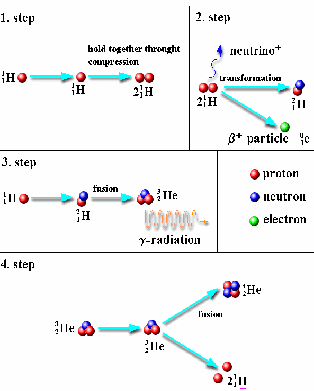The general name for the creation of elements heavier than hydrogen as a result of fission is nucleosynthesis. In main sequence stars, protons are fused together in the core to make heavier nuclei in a process called the p – p cycle.

In order for any of these reactions to take place, two positively charged particles (hydrogen or helium nuclei) need to overcome the force of electrostatic repulsion and approach close enough for nuclear reactions to take place. This implies they must be moving very fast, or that the temperature is very high since temperature is a measure of kinetic energy. This is the case in the core of a main sequence star. A balance is maintained in the core of the star between energy production and the movement of energy from the core of the star. This maintains the core of the star at a steady temperature and ensures steady energy production for however long the str is on the main sequence – from millions to billions of years.
Eventually the hydrogen in the core is exhausted and the star reaches the end of it's main sequence lifetime.
